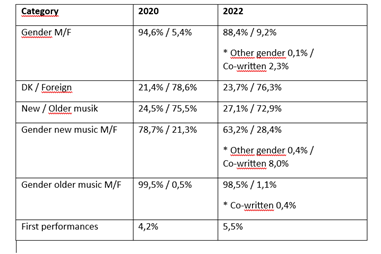For the third time Danish Composers’ Society, Art Music Denmark, Edition Wilhelm Hansen, Music Publishers’ Association Denmark, and Edition-S publish statistics on the repertoire played in Danish concert halls, opera houses and at festivals around the country.
Putting more new music on the program is a simple and concrete approach that ensures a better balance between the genders in the repertoire. This is one of the conclusions of the third statistics of the repertoire played on the classical music and sound art stage in the 2020/2021 and 2021/2022 seasons.
Overall, the key figures at national level show progress on several parameters; more music written by women, more Danish music, more new music and a small increase in the number of premieres:
Key figures from the statistics in 2020 and 2022

* Compared to the previous two statistics, we have added two categories for information on gender; partly ‘other gender’ partly the category ‘collectively’. We have done this to reflect the development of the music scene in these years, where a binary view of gender is giving way to a recognition of several different gender identities, and a tendency for many works to be created collectively, that is, by several authors together.
Festivals and ensembles at the forefront of gender diversity
If you look behind the numbers, however, it is especially among the festivals and ensembles that we find the frontrunners when it comes to more diversity in the repertoire. Overall, over the two seasons, 56% of music performed at festivals was new music composed within the last 30 years – of which a whopping 40.2% of works were written by women (up from 24.8% in the previous statistics). In the two seasons combined, 41.2% of the repertoire was written by Danish composers and 13.8% were first performances.
The orchestras lag behind
The large state-supported orchestras, on the other hand, continue to lag badly behind on virtually all parameters. Overall, only 1.5% of the music programmed in the 2020/2021 and 2021/2022 seasons was written by women – a decrease from the most recent statistics in 2020, when the figure was 3%. Music composed within the last 30 years made up 11.6% of the repertoire, and only 1.5% of the programmed works were premieres.
Lack of geographic diversity
In terms of diversity among the countries of origin of the music, no progress can be traced in the overall statistics; 76.3% of the music in the two seasons was by foreign composers, of which just under 44% came from Italy, Austria, and Germany.
Juliana Hodkinson, chair of the Danish Composers’ Society, says about the figures:
A big thank you to all those who have contributed to the progress in gender balance within both new and historical music. Especially the significant leap that some ensembles and festivals have succeeded in taking in the last few years. It is crucial for both musical life and the audience that the repertoire is experienced as something that is agile, up-to-date, relevant, and that plays into our times.
In Denmark, however, we still miss feeling the exciting developments that are taking place in a number of other countries where even the largest and most established orchestras and opera houses are pushing for change and social relevance by programming music in new ways that are not congealed in old worldviews. It attracts new audiences and listeners – not least to new music.
It is strange that historical music from, for example, Germany occupies so much space in the Danish repertoire, when the repertoire in Germany itself looks more and more to the world and to the future. Not to mention the USA, where the classical market is booming with new commissions and new discoveries in the historical musical heritage. We must also achieve that in Denmark!